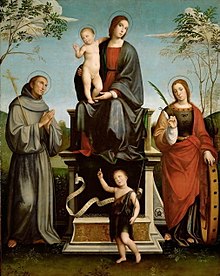Francesco Francia
Francesco Francia (* 1447 in Bologna , † 5. January 1517 in Bologna; actually Francesco Raibolini ) was an Italian Renaissance - painter , goldsmith , engraver and sculptor . He is considered the founder of the Bolognese school of painting.
Life
Francia is described by Vasari in the second part of his famous artist biographies (Le vite dei più eccellenti architetti, pittori et scultori italiani).
Before he turned to painting in 1485, he trained as a goldsmith. He studied with the Italian painter Francesco Squarcione . His pictures are mainly characterized by the representation of the Virgin Mary and saints . He also painted portraits . Among his students were Innocenzo Francucci , called Innocenzo da Imola, and the engraver Marcantonio Raimondi . Over 300 students are said to have passed through his workshop over his lifetime.
In 1483 he became chairman of the goldsmiths' guild, which office he held repeatedly (1489, 1506–1508 and 1512). In 1514 he became chairman of the four arts. Appointed mint master by the Bentivogli and confirmed as such by Pope Julius, Francia gained an important reputation in die cut, silver ornament and niello. Two of his Niello plates are in the Bologna Academy.
He is more famous in painting, in which he was influenced by Lorenzo Costa - in other sources Lorenzo Costa is considered to be his student. As a Northern Italian, Francia was not as trained in Florentine drawing as Perugino and therefore his figures appear more slack and flat. Usually a few figures are sufficient for him, in which he knew how to bring a measured, solemn expression, a tender soul life, especially with the female figures. Francia and Perugino are considered to be the real pioneers of the High Renaissance in central Italy. By increasingly turning away from the realistic tendencies of the Quattrocento in favor of idealization, they were already approaching the classical style, which Raphael would then be perfectly elaborated. Francia and Raffael were on a friendly basis (correspondence from 1508). From Vasari the anecdote is passed down that Francia died at the sight of Raphael's “ The Rapture of Saint Cecilia ” ( Pinacoteca Nazionale di Bologna ).
His portrait of Isabella d'Este 1511 (believed to be lost) is also famous , as this is considered a prime example in art history of the lack of model sessions in the Renaissance. Without a model session, Francia painted the margravine based on a strange drawing (probably Lorenzo Costa or Leonardo's famous profile drawing) and the oral description of her half-sister. Isabella was so enthusiastic that in 1536, at the age of 62, she again gave Titian to Titian as the template for a rejuvenating portrait (again without a model session). The result is Titian's "Black Isabella" in the Kunsthistorisches Museum Vienna .
Pictures of him (and his workshop) are quite common, especially many of Bologna (Madonna from 1490 in the Misericordia, Madonna from 1499 in the Bentivogli Chapel of San Jacopo Maggiore, the dead Christ and a Madonna in the Pinacoteca, frescoes from the story of St. Cecilia in the Oratorio di Santa Cecilia etc.). Munich has the Madonna in the Rosenhag, Dresden the Adoration of the Three Magi and the Baptism of Christ on the right, Berlin a Madonna from 1502 and a holy family from his youth, the National Gallery in London a Madonna, the Louvre in Paris Christ on the cross Job, the gallery in Parma, a Descent from the Cross, etc. Francia's sons Giacomo (born before 1487, died 1557, the more important) and the younger Giulio (born 1487, died after 1543), worked in the style of their father, but with less talent . Their works are often passed for those of the father; The brothers also painted several of them together, as they also worked on the father's works.
Works (selection)
- Madonna im Rosenhag , 1500-5 (Alte Pinakothek, Munich)
- Madonna and Child with Saints Francis and Jerome , 1500–10 (Metropolitan Museum, New York)
- Mary with child, St. Franziskus, Katharina and the Johannesknaben , 1504 (Kunsthistorisches Museum, Vienna)
- Bishop Altobello Averoldo , ca.1505 (National Gallery of Art, Washington)
- Wedding ( Sposalizio di Cecilia e Valeriano ) and funeral ( Sepoltura di santa Cecilia ) of St. Lucia, 1505–1506 ( Oratorio di Santa Cecilia , Bologna)
- Evangelista Scappi , 1505–1515 (Gallerie Fiorentine, Florence)
- Baptism of Christ , 1509 ( Old Masters Picture Gallery , Dresden)
- Federigo Gonzaga (son of Isabella d'Este), 1510 (Metropolitan Museum, New York)
literature
- Giorgio Vasari: Le vite dei più eccellenti architetti, pittori et scultori italiani. Florence 1568.
- George C. Williamson: Francesco Raibolini, called Francia. London 1901.
- Giuseppe Piazzi: Le Opere di Francesco Raibolini, detto il Francia, orefice e pittore. Azzoguidi, Bologna 1925.
- Emilio Negro, Nicosetta Roio: Francesco Francia e la sua scuola. Artioli Editore, Modena 1998, ISBN 8877920572 .
- Sally Hickson: Giovanni Francesco Zaninello of Ferrara and the portrait of Isabella d'Este by Francesco Francia. Renaissance Studies Vol. 23 No. 3, 2009, pp. 288-310.
Web links
Individual evidence
- ↑ http://www.virtualuffizi.com/biography/Francesco-Raibolini-called-Francia.htm
- ^ L. Forrer: Biographical Dictionary of Medallists . Francia. Volume II. Spink & Son Ltd, London 1904, p. 137 ff .
- ^ L. Forrer: Biographical Dictionary of Medallists . Francia (Francesco Raibolini). Volume VII. Spink & Son Ltd, London 1923, pp. 318 .
| personal data | |
|---|---|
| SURNAME | Francia, Francesco |
| ALTERNATIVE NAMES | Raibolini, Francesco (real name) |
| BRIEF DESCRIPTION | Italian Renaissance painter, goldsmith and sculptor |
| DATE OF BIRTH | 1447 |
| PLACE OF BIRTH | Bologna |
| DATE OF DEATH | January 5, 1517 |
| Place of death | Bologna |



